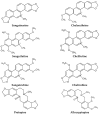Sanguinaria canadensis: Traditional Medicine, Phytochemical Composition, Biological Activities and Current Uses
- PMID: 27618894
- PMCID: PMC5037693
- DOI: 10.3390/ijms17091414
Sanguinaria canadensis: Traditional Medicine, Phytochemical Composition, Biological Activities and Current Uses
Abstract
Sanguinaria canadensis, also known as bloodroot, is a traditional medicine used by Native Americans to treat a diverse range of clinical conditions. The plants rhizome contains several alkaloids that individually target multiple molecular processes. These bioactive compounds, mechanistically correlate with the plant's history of ethnobotanical use. Despite their identification over 50 years ago, the alkaloids of S. canadensis have not been developed into successful therapeutic agents. Instead, they have been associated with clinical toxicities ranging from mouthwash induced leukoplakia to cancer salve necrosis and treatment failure. This review explores the historical use of S. canadensis, the molecular actions of the benzophenanthridine and protopin alkaloids it contains, and explores natural alkaloid variation as a possible rationale for the inconsistent efficacy and toxicities encountered by S. canadensis therapies. Current veterinary and medicinal uses of the plant are studied with an assessment of obstacles to the pharmaceutical development of S. canadensis alkaloid based therapeutics.
Keywords: Sanguinaria canadensis; alkaloid; black salve; bloodroot; escharotic; herbal; sanguinarine; skin cancer.
Conflict of interest statement
The authors declare no conflict of interest.
Figures



References
-
- Vogel V.J. American Indian Medicine. University of Oklahoma Press; Norman, OK, USA: 2013.
-
- Slavik J., Slavikova L. Alkaloide der mohngewächse (papaveraceae) XVII. Über neue alkaloide aus Sanguinaria canadensis L. Collect. Czechoslov. Chem. Commun. 1960;25:1667–1675. doi: 10.1135/cccc19601667. - DOI
-
- Damm D.D., Fantasia J.E. White patch of maxillary vestibule. Sanguinarine-associated leukoplakia. Gen. Dent. 2002;50:466. - PubMed
Publication types
MeSH terms
Substances
LinkOut - more resources
Full Text Sources
Other Literature Sources

